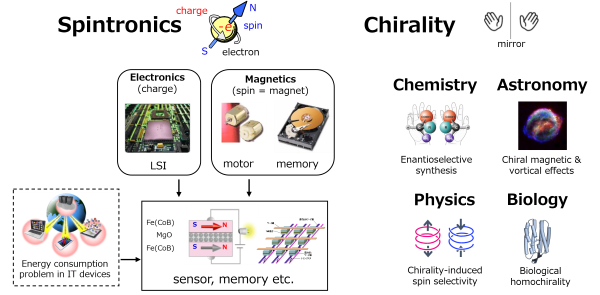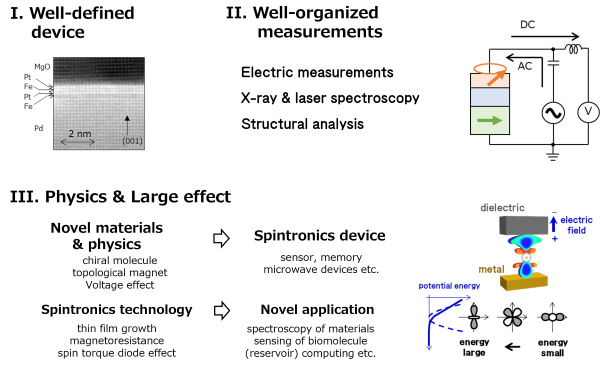Research
Background

Concept

Topics

We focus our studies on condensed matter and materials physics, particularly in the realm of nanomaterials, where the properties of spin can be transformative. Our work involves creating atomically controlled quantum materials composed of metals, insulators, and organic molecules. The aim of our research is to harness quantum physics to develop new nanostructures with advantageous physical physical properties and to understand their microscopic origins. Although the periodic table contains only a few magnetic materials, such as Fe and Co, the potential expands significantly when we explore multilayers These multilayers combine magnetie elements (such as Fe, Co, Ni, and Mn) with non-magnetic elements (including V, Cu, Sn, Au, Pt, Ir) , as well as organic and biomolecular materials. The deversity of these combinations offers nearly infinite possilibities in material design and application.
Our research delves into the fascinating field of quantum spintronics, focusing on three primary areas:
1. Chiral Molecular Spintronics: Here, we explore spintronic devices that incorporate chiral molecules, including chiral phthalocyanines/perovskites and biomolecules such as proteins. By leveraging the unique property of spin currents, we aim to develop innovative spintronic functionalities.
2. Quantum Materials Spintronics: Our studies extend to spintronic devices utilizing topological magnetic materials, such as the chiral antiferromagnet Mn3Sn. We harness the distinctive electronic structures of quantum materials to create novel spintronic devices.
3. Operando Spectroscopy: This aspect of our research focuses on the device physics of quantum spintronics. We employ advanced techniques like femtosecond pulse laser and X-ray magnetic circular dichroism spectroscopy/imaging to gain deeper insights.
We conduct these studies on quantum spintronic devices using cutting-edge fabrication and measurement technologies.
家電製品やパソコン・自動車をはじめとした生活必需品では磁性体、すなわち磁石が重要な役割を担います。このように私たちの身の回りは磁性体であふれています。三輪研究室では磁性の主な起源である電子の自転角運動量に相当するスピンの性質がナノの世界で顕著に現れることに着目し、これを利用して高度なレベルでエレクトロニクスを実現する量子スピントロニクスの研究を行っています。特に原子層成長技術を駆使した高品質かつ特徴的なナノ構造を有する新奇量子スピントロニクスデバイスを作製し、その物性を研究します。元素の周期表において磁性材料はFeやCoのようにごく限られています。しかし、Fe・ Co・ Ni・Mnをはじめとした磁性体、V・ Cu・Sn・Au・Pt・Irなどの非磁性体、金属と異なる対称性や機能を有するフタロシアニンや生体分子等の有機分子、これらを原子・分子レベルで自在に組み合わせることにより、新たな物の性質(物性)が生みだします。
1. キラル分子スピントロニクス
キラルフタロシアニンのように実空間に特徴的な構造を有するキラル分子、タンパク質に代表される生体分子等を用いた新奇スピントロニクス研究を展開します。スピン角運動量の流れであるスピン流がtruly chiralである点に着目し、生体分子スピントロニクスデバイスを用いた『スピントロニクス分子生物学』という新たな学問分野の創成を目指します。
2. 量子物質スピントロニクス
ワイル磁性体であるカイラル反強磁性金属Mn3Snをはじめとしたトポロジカル磁性体のように運動量空間に特徴的な電子状態を有する量子物質を用います。これによりFe/MgOをはじめとした従来材料を用いたスピントロニクスを超えるデバイス物性の発現を目指します。
3. フェムト秒パルスレーザーや放射光X線を用いたオペランド分光
フェムト秒パルスレーザーやX線磁気円二色性分光等を用いた最先端の分光や顕微イメージング技術を利用し、量子スピントロニクスデバイスの物理機構を解明します。
4. スピンによる脳型コンピューティング
スピンダイナミクスの非線形性に着目し、新規コンピューティングを開拓します
個々の研究テーマにより細部は異なりますが、広くは新たな材料系が示す新たな物性を見つけ、電子デバイス材料として機能化して応用に供することが研究目的です。
和文解説(スピントロニクス入門):
「量子スピントロニクス現象を示す新物質について」電気学会誌 139, 601 (2019)
「磁気抵抗効果を使ったスピントロニクス現象」電気評論 105, 21 (2020)
Topics
- Metal-organic hybrid devices using functional molecules
・K. Kondou et al., J. Am. Chem. Soc. 144, 7302 (2022).
・S. Miwa et al., Appl. Phys. Express 13, 113001 (2020). Spotlights 2020
・H. Gamou et al., Nano Lett. 20, 75 (2020).
キラル分子を用いたスピントロニクスデバイス:
有機分子は無機金属と比べてとても設計自由度の高い魅力的な材料であり、本テーマでは強磁性金属と有機分子との界面で生じる特徴的な電子状態を見出して機能化します。これまでに分子へのスピントランスファー効果やキラル分子を用いた新たなスピントロニクス現象を発見しました。 - Spintronics device with a topological magnet
・S. Sakamoto et al., Nat. Nanotechnol. 20, 216 (2025).
・X. Chen et al., Nature 613, 490 (2023).
・T. Higo et al., Nature 607, 404 (2022).
・S. Miwa et al., Small Science 1, 2000062 (2021).
・H. Tsai et al., Nature 580, 608 (2020).
トポロジカル磁性体を用いたスピントロニクスデバイス:
運動量空間に非自明な電子状態を持つトポロジカル磁性体を用いると、従来の強磁性金属とは異なる性質が得られます。具体的には反強磁性体であるにも関わらず強磁性体のような応答を示したり、強磁性体の応答が増強されます。これまでにトポロジカル反強磁性金属が強磁性体よりも100倍速い応答速度を示すことやスピン流による状態制御、磁気抵抗効果を実証しました。 - Operando spectroscopy to characterize interfacial magnetism and magnetoelectric
effect
・S. Miwa et al., J. Phys. D: Appl. Phys. 52, 063001 (2019).
・S. Miwa et al., Nat. Commun. 8, 15848 (2017).
・T. Kawabe et al., Phys. Rev. B 96, 220412(R) (2017).
オペランド分光による界面磁性や電気磁気効果の機構解明:
強磁性金属界面ではスピン軌道相互作用に起因する軌道磁気モーメントや磁気双極子Tz項といった物理量が顕著に現れます。これらは磁気異方性と密接に関係し、スピントロニクスデバイスを駆動するために必要な磁性の電気的制御を理解するのに重要です。放射光X線を使ってデバイスを動作させながら分光を行う「オペランド分光」により電気磁気効果の起源を解明しました。
・[和文解説] SPring-8/SACLA利用者情報 23, 8(2018).
・[和文解説] 元素戦略プロジェクト/大型研究施設 連携シンポジウム 研究ダイジェスト - Interface-engineering to realize giant spin-torque
・S. Miwa et al., Phys. Rev. X 7, 031018 (2017).
・S. Miwa et al., Nat. Mater. 13, 50 (2014).
磁性多層膜デバイスの界面ナノ制御による巨大スピントルク:
界面磁気異方性の制御制御によりスピン流の非線形効果が増強されて巨大なダイオード効果を示すことや、FeとMgOのエピタキシャル接合において非自明な電気磁気効果が生じることを示しました。 - Brain-inspired computing with spintronics
・T. Furuta et al., Phys. Rev. Applied 10, 034063 (2018).
スピントロニクスを利用した脳型コンピューティング:
スピンの歳差運動は非線形かつ履歴を持つため演算能力を有します。スピントロニクスデバイスを用いて、脳型演算と呼ばれるリカレントニューラルネットーワークの一種である「レザバコンピューティング」を行えることを示しました。
Access
〒277-8581
千葉県柏市柏の葉5-1-5
東京大学 物性研究所 三輪研究室
A330 TEL: 04-7136-3301
A329 TEL: 04-7136-3300
A330, Miwa group, The Institute for Solid State Physics, 5-1-5 Kashiwanoha,
Kashiwa, Chiba 277-8581, Japan
Map